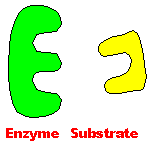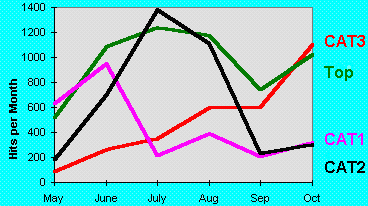CATs make up a very significant part of the VCE assessment. A CAT (Common Assessment Task) may be a research project or assignment or it may be an exam. The requirements are set at a state level.

What ?
This happy little cat has become a familiar image to a large number of VCE biology students. They have discovered a "site" that provides factual material and good, honest advice that helps with what is a very stressful school year.Over recent years, staff in the School of Biochemistry at La Trobe University have become concerned with the number and scope of requests for technical information by students preparing CATs. Although we wanted to help, there was a feeling that often students were searching for material inappropriate for their level of knowledge.
At the same time, we were aware that students seemed to have very little idea of what sort of work biochemists do, how valuable it is and how well it is done at La Trobe.
Professor Nick Hoogenraad, Head of the School of Biochemistry, decided that the School should invest some $40,000 to place on the internet quality information that was available to some students at well resourced schools, but beyond the reach of most.
Thus was born the LTU Biochemistry CAT project. We hoped that by offering accurate and relevant information in the area of applied genetics, all neatly packaged up at one site, we could :
- Contact students, especially the more creative ones who are willing to look a bit further afield.
- Contact their teachers and help to keep their knowledge current in a rapidly changing field.
- Guide both teachers and students in their choice of research projects and material.
- Establish in the students' minds that La Trobe may be a good place at which to study.
David Bannon (email) B.Sc (Comp.Sc) manages the Biochemistry computer network including its Web pages. Biochemistry was one of the first departments at La Trobe to have a Web presence. David produced most of the VCE-CAT illustrations and looked after the server side of things.
A poster was distributed rather than a brochure because we were advised that brochures get filed and posters are pined to notice boards !
The VCE-CAT project is made available to the public via the Departmental server, a four year old DEC Alpha unix computer running the (free) NCSA web server software. The same computer provides file, print and email services to the Department and still performs adequately.
How ?
Having decided what we wanted, we needed to find the right team to put it together. There seemed to at least be three separate skills required :- Ability to write Web pages, ie HTML literacy.
- Knowledge of the science concerned, applied genetics.
- Knowledge of the VCE and CATs
 We contacted STAV and found what we needed. Jenny Herington knew her VCE biology backwards, had experience in biochemistry and molecular biology and was willing to learn all about Web writing. And yes, she would write at HTML level! We negotiated a nine month "sabbatical" for Jenny, paid for a temporary replacement for her at Caulfield Grammar and she started at the beginning of 1997.
We contacted STAV and found what we needed. Jenny Herington knew her VCE biology backwards, had experience in biochemistry and molecular biology and was willing to learn all about Web writing. And yes, she would write at HTML level! We negotiated a nine month "sabbatical" for Jenny, paid for a temporary replacement for her at Caulfield Grammar and she started at the beginning of 1997.In VCE biology, CAT One is an exam, CAT Two a research project and CAT Three another exam. Jenny, with the help of David Bannon, soon had Web pages appearing. Stage one (and three) consisted of comprehensive sets of study notes.
Stage two involved conducting interviews with each member of staff about their research activities.
These interviews were heavily biased towards the type of information that students needed to produce their CATs. It was here that we discovered a fourth necessary skill, an editorial ability. Jenny found it difficult to convince some of the researchers that she knew best what level of technical detail the project should offer but she persisted!
A small (A4) but eye catching poster advertising the site was distributed to every high school in Victoria. Paid advertisments were placed in the STAV monthy newsletters. An effort was made to create some "brand recognition" of the little black "biology cat" that appears near the top of this document. The site now offers not only technical information but also detailed advice about how to study the subject and how to present CATs to achieve the best possible results. Students are permitted to use any of the extensive array of illustrations in their work.

This system also gave us a look at what browsers people were using. In October 1997 we recorded approx.
- Netscape 67%
- Explorer 31%
- Other 2%
Results !
Although it is difficult to directly measure the results of a project like this, particularly until a comparison of yearly enrollments is possible, the indications are very good. Although a hit count gives no indication of user's satisfaction, it does at least measure how many people know about the site. The counting method produced a very conservative count, for example using a school library's computer, a number of students could access the site and only record one hit. Further, people who entered the site without going through one of the four opening pages were not counted.
This chart shows how people first entered the site. In any one month new hits are the sum of the four values plus however many we missed ! As can been seen, the three individual sections peaked sequentually, in accord with the VCE timetable.
Our best indicator so far about user satisfaction is the very large number of emails we received from students, some requesting further information and some just saying thanks. Quite a number of teachers also contacted us looking for help and we had many visits to the department from students and teachers wishing to meet the "Cat Lady".
Significantly, many students asked if we knew of other sites dealing with the many other subjects covered by the VCE.